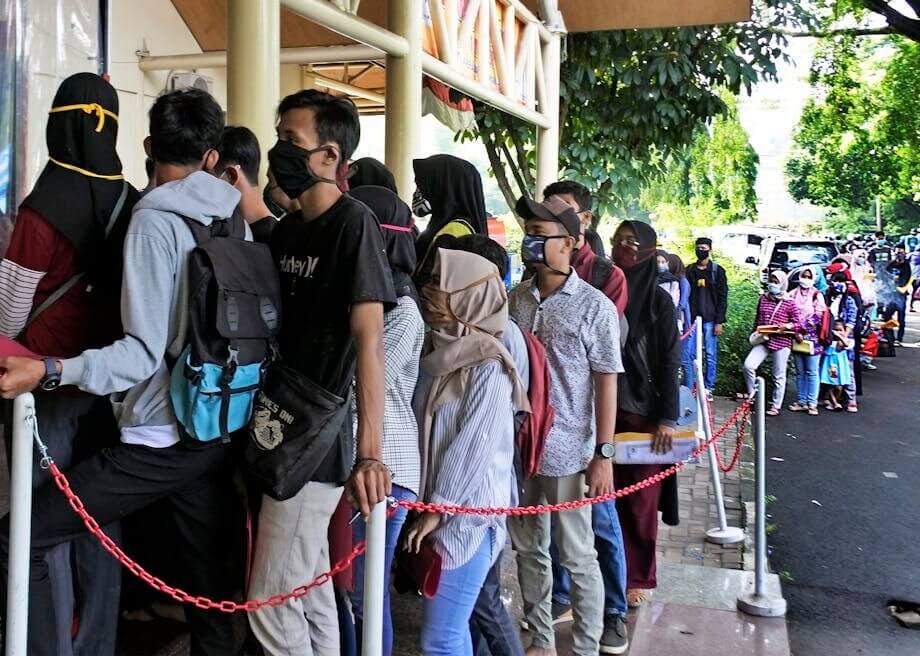Indonesia’s Unemployment Crisis: A Nation at a Crossroads
Indonesia, Southeast Asia’s largest economy, is facing a mounting unemployment crisis that has captured national attention and sparked debate about the country’s economic direction. The recent chaos at a job fair in Bekasi, where 25,000 jobseekers competed for just 2,000 positions, has become a symbol of the deep challenges facing millions of Indonesians—especially the youth—who are struggling to find stable, meaningful work. This article explores the roots of Indonesia’s unemployment problem, the limitations of current solutions like job fairs, and the broader economic and social implications for the nation’s future.
- Indonesia’s Unemployment Crisis: A Nation at a Crossroads
- Job Fairs: A Symptom, Not a Solution
- The Rise of Informal Work and Its Consequences
- Youth Unemployment: A Generation at Risk
- Economic Headwinds: Global and Domestic Challenges
- Government Responses: Training, Stimulus, and Policy Shifts
- Structural Solutions: Building a Resilient Labor Market
- Broader Implications: Social and Political Consequences
- In Summary
Job Fairs: A Symptom, Not a Solution
The Bekasi job fair in May 2025 made headlines for all the wrong reasons. Thousands of hopeful applicants surged into the venue, jostling for access, with some fainting in the crush. The event, intended to connect jobseekers with employers, instead highlighted the stark imbalance between the number of people seeking work and the limited opportunities available. According to Indonesia’s Central Statistics Agency (BPS), there were 7.28 million unemployed working-age people as of February 2025, an increase of 83,000 from the previous year. The unemployment rate stood at 4.76 percent, only marginally lower than the previous year, but the working-age population grew by 2.79 million, intensifying competition for jobs.
Job fairs have become increasingly crowded and chaotic, reflecting the desperation of jobseekers and the inadequacy of such events to address the underlying issues. As Anton J Supit of the Indonesian Employers Association (Apindo) noted, the overwhelming turnout at job fairs is clear evidence of a mismatch between the supply of jobseekers and the demand for labor. Many companies attend these fairs as a formality, with some reportedly not offering real vacancies, further fueling frustration among attendees.
While job fairs can help reduce the time and effort required for job searches, experts agree they are only a short-term measure. Jahen Fachrul Rezki, Deputy Director at the University of Indonesia’s Institute for Economic and Community Research, emphasized that job fairs alone cannot solve Indonesia’s unemployment problem, especially when structural issues like economic weakness, rising informality, and declining productivity remain unaddressed.
The Rise of Informal Work and Its Consequences
One of the most significant trends in Indonesia’s labor market is the dominance of informal employment. As of February 2025, 59.4 percent of Indonesian workers—about 86.58 million people—were employed in the informal sector. This is a slight increase from the previous year and is much higher than neighboring Malaysia, where only 26.8 percent of the workforce was informal in 2022. Informal jobs, such as street vending or small-scale farming, often lack job security, stable income, health insurance, and other benefits associated with formal employment.
The informal sector serves as a safety net for those unable to secure formal jobs, but it also leaves workers vulnerable to economic shocks and exploitation. Economist Teguh Dartanto from the University of Indonesia explained that while informal workers are not counted as unemployed if they earn any income, their precarious situation is often overlooked in official statistics. This reliance on informal work is both a symptom and a cause of Indonesia’s persistent unemployment and underemployment issues.
Youth Unemployment: A Generation at Risk
The burden of unemployment falls disproportionately on Indonesia’s youth. The unemployment rate for those aged 15 to 24 is a staggering 16.16 percent—more than three times the national average. This figure is higher than in many neighboring countries and has remained stubbornly high for over a decade. Many young Indonesians, including university graduates like Marsha Dita, find themselves unable to secure jobs that match their qualifications, leading to frustration and disillusionment.
The high rate of youth unemployment points to a disconnect between the education system and the needs of the labor market. Vocational high school graduates, who are supposed to be job-ready, actually record the highest unemployment rates. The curriculum often fails to equip students with the technical and soft skills demanded by employers, and access to quality education remains uneven, particularly in rural areas.
Education and Skills Mismatch
Ali Marzuki Zebua, an academic at IAIN Kerinci, argues that the root of the problem lies in the outdated education system, which does not keep pace with technological and economic changes. The lack of vocational training and innovative teaching methods, combined with a recruitment culture that favors connections over competence, further disadvantages young jobseekers. Comprehensive reform is needed to align curricula with industry needs, strengthen vocational education, and integrate technology into teaching and learning.
Economic Headwinds: Global and Domestic Challenges
Indonesia’s unemployment crisis cannot be separated from broader economic trends. The country’s GDP grew by 4.87 percent in the first quarter of 2025, below expectations and down from 5.11 percent the previous year. The World Bank forecasts growth of 4.7 percent for the year, reflecting both external and internal pressures. Global trade tensions, particularly the US-China trade war, have dampened export demand and foreign investment, while domestic austerity measures have led to significant layoffs in sectors like hospitality and manufacturing.
Government budget cuts totaling over 300 trillion rupiah (about US$19 billion) have reduced spending on ministries, state agencies, and regional administrations. This has had a ripple effect on industries dependent on government contracts, resulting in nearly 74,000 layoffs between January and March 2025 alone. As consumer spending declines, a vicious cycle of reduced demand, job cuts, and further economic slowdown takes hold.
Deindustrialization and the Future of Work
Indonesia is also grappling with deindustrialization—a decline in the manufacturing sector that has traditionally provided large numbers of jobs. The closure of factories and the shift toward services and informal work threaten to erode the country’s economic base. Experts warn that if this trend continues without sufficient investment in new industries and innovation, Indonesia risks missing the opportunity to fully benefit from its demographic dividend—a period when the working-age population is at its peak.
Arief Anshory Yusuf, a member of Indonesia’s National Economic Council, cautions that premature deindustrialization could lead to increased competition for low-productivity service jobs, reduced incomes, and greater social inequality. To counter this, Indonesia needs to revitalize industrial zones, invest in vocational education, and promote research and innovation.
Government Responses: Training, Stimulus, and Policy Shifts
In response to the crisis, the Indonesian government has launched several initiatives aimed at boosting employment and supporting jobseekers. The Prakerja program, now in its fifth year, offers skilling, upskilling, and reskilling opportunities to millions of Indonesians, with a focus on inclusivity for women, people with disabilities, and those in underserved regions. Over 18.9 million participants have accessed more than 6,000 training modules, ranging from digital skills to hospitality and engineering.
Denni Purbasari, Executive Director of the Prakerja Project Management Office, emphasizes the program’s commitment to reaching low-skilled workers and those without university education. By providing both online and face-to-face training, Prakerja aims to bridge the skills gap and prepare the workforce for the demands of a changing economy.
The government has also rolled back some austerity measures, allowing civil servants to resume travel and meetings at hotels to stimulate sectors hit by spending cuts. Stimulus programs, such as travel discounts, have been introduced to boost domestic consumption. However, analysts like Bhima Yudhistira of the Center of Economic and Law Studies (CELIOS) argue that these measures are akin to “providing paracetamol”—offering temporary relief without addressing the root causes of unemployment.
Private Sector and International Initiatives
The private sector, including multinational companies and organizations like the American Chamber of Commerce in Indonesia (AmCham), has also stepped in to support workforce development. Career fairs organized by AmCham and U.S. companies provide job opportunities, skill-building workshops, and networking for young professionals. These events highlight the importance of soft skills, adaptability, and lifelong learning in today’s job market.
PepsiCo’s recent investment in a new factory in West Java, for example, is expected to create new jobs and demonstrates the potential of foreign direct investment to drive employment. However, such initiatives must be scaled up and complemented by broader policy reforms to have a meaningful impact on the national unemployment rate.
Structural Solutions: Building a Resilient Labor Market
Experts agree that tackling Indonesia’s unemployment crisis requires a multi-pronged approach:
- Education Reform: Align curricula with industry needs, strengthen vocational and technical training, and ensure access to quality education across all regions.
- Investment in Labor-Intensive Sectors: Stimulate job creation in manufacturing, agriculture, and services through targeted incentives and infrastructure development.
- Support for MSMEs: Micro, small, and medium enterprises (MSMEs) account for around 60 percent of employment. Providing access to capital, training, and markets can help these businesses grow and absorb more workers.
- Inclusive Training Programs: Expand initiatives like Prakerja to reach more vulnerable groups and adapt training to the evolving demands of the digital economy.
- Policy Coordination: Harmonize efforts across ministries, regional governments, and the private sector to ensure coherent and effective job creation strategies.
Community-based solutions, such as productive zakat programs run by organizations like Dompet Dhuafa, also play a role in empowering individuals to start businesses and achieve economic independence, particularly in rural areas.
Broader Implications: Social and Political Consequences
The persistence of high unemployment, especially among the youth, has significant social and political ramifications. Public frustration is mounting over unfulfilled campaign promises, such as President Prabowo’s pledge to create 19 million net new jobs. Political analysts warn that continued economic hardship could erode trust in government and fuel social unrest.
Moreover, the reliance on informal work and the lack of decent job opportunities threaten to undermine Indonesia’s long-term economic potential. Without decisive action to create quality jobs and equip the workforce with relevant skills, the country risks squandering its demographic dividend and falling behind regional peers.
In Summary
- Indonesia faces a growing unemployment crisis, with 7.28 million jobless and a youth unemployment rate of 16.16 percent.
- Job fairs, while popular, are insufficient to address the structural mismatch between jobseekers and available positions.
- The informal sector dominates employment, leaving many workers without job security or benefits.
- Economic headwinds, including global trade tensions and domestic austerity, have slowed job creation and led to layoffs.
- Education and skills mismatches are major contributors to youth unemployment, highlighting the need for curriculum reform and vocational training.
- Government initiatives like Prakerja and private sector efforts offer some relief but require scaling and better alignment with industry needs.
- Comprehensive solutions must include education reform, investment in labor-intensive sectors, support for MSMEs, and coordinated policy action.
- The stakes are high: failure to address unemployment could have lasting social, economic, and political consequences for Indonesia’s future.












